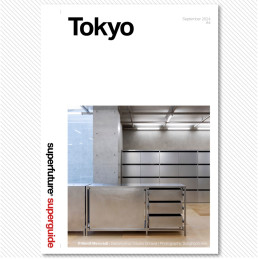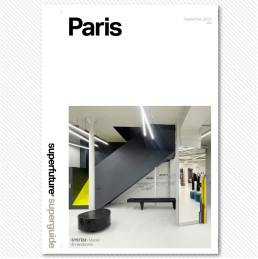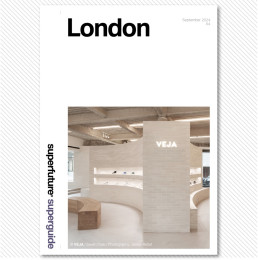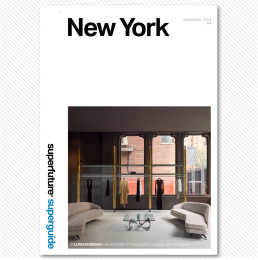
Since its inception little over a decade ago, the 1290SQM store has not only seen three incarnations, created an ever-growing influential fanbase, but also shook up the luxury retail game in its hometown of Istanbul. Co-founded by advertising professional-turned-retailer Ali İşitir (1986), the store stands out in the city’s luxury retail landscape, offering not only a tightly curated mix of high-end brands with a quirky aesthetic and utilitarian silhouettes, but also a magnificent retail space designed by artists. Understandably, 1290SQM has become the go-to address for Istanbul‘s savvy creative community, while many a fashion-forward overseas shopper can also increasingly be found stocking up here. Interestingly, the foundation of the store lies 2,196 kilometres (1,365 miles) northwest of this sprawling city, in Amsterdam to be precise. It’s in the Dutch capital where 1290SQM‘s other co-founder, retailer Ido de Voos had established the innovative 90SQM concept store in 2001, an equally groundbreaking store concept which eventually spawned the store in Istanbul. Initially operating a 290 sqm. space in Beyoğlu, the store relocated three years later to bigger premises, 1290 sqm. to be precise, in the Akaretler neighbourhood. In its latest chapter, 1290SQM occupies a semi-secluded, artist-led space at Zorlu Center, arguably the leading luxury shopping destination in this sprawling seaside metropolis. Superfuture sits down with the amiable and insightful İşitir who, still after all these years, passionately conveys a retail vision which is very much anchored by genuine personal connections and fostering a discerning personal taste.
So, the 1290SQM store is a collaborative effort of you and Ido. Who does what for the store? You know, when we started, we put a lot of brands on the map for the Turkish market. Ironically, about a decade ago, even the CEO’s of many sports brands such as adidas and Nike told Ido and I that introducing their brands wouldn’t work here. They said Turkey wasn’t the right market, it didn’t have the right mindset. You’ll go bust in three months, they said. We disagreed, obviously, and simply old them, it’s our money we’re putting in, and if it doesn’t work, well, we would’ve probably learned a good lesson! Ido and I truly believed in a new Turkish generation of young savvy consumers and that we’d be able to build a thriving community. Additionally, we were confident that we’d also be able to connect with an older, more established generation between 35 and, let’s say, 60 years, a demographic of professionals who hadn’t been very conscious about dressing or brands, but who were susceptible to living in style and become customers of ours. You know, creating an awareness of all that, and also, of what’s going on elsewhere in the world in terms of fashion. We wanted to transform that local and traditional mindset to a global, more sophisticated mindset.
I’ve literally had corporate honchos come up to me and ask me to dress them from head to toe. I mean, these were top managers of large companies or business owners who didn’t like to shop and who always had been dressed by their mums when they were kids, and later on in life by wives or girlfriends. There was a whole generation of men which was brought up like that, and obviously, we wanted to break that mold. This generation only goes shopping once or twice a year, spending a lot of cash on a new wardrobe in one go just to get it over with. The 1290SQM store changed that shopping routine, simply because I actually wanted to get to know the customer. I set out to teach this customer the joy of shopping for himself. Interestingly, this kind of customer turned out to be too shy or too afraid to pick something as simple as a T-shirt despite running a large, multimillion dollar business. So, I literally had to educate them, telling how important it is to feel the fabric of the garment, experience the fit, and so on, allowing them to discover their own preferences and taste.

I sent people away with a single T-shirt although they wanted to spend a lot of cash. This approach really made them think, but in the end, also created trust, because I didn’t go for the cut-throat sale. Here in Istanbul, there were, and are still, many, many of such consumers. So, we were successful in connecting with an older generation of clients, but also with younger demographics who, through internet and social media, already knew about the brands we carry, but until the opening of our store, didn’t have a place to shop here in town. Coming back to your question—in the past, when the Amsterdam store still existed, our roles were more defined, meaning he ran his store, and I managed mine. However, if one of started or launched something in one shop, we’d always discuss it it would work in the other one as well. But when the Amsterdam store closed, the focus obviously shifted to Istanbul, and Ido continues to enjoy being involved here on many levels. You know what’s so funny? Both Ido and I are anti-social characters, but because of our stores, we’ve become super social. Working in retail means you meet lots of people on a daily basis, constantly communicating, but when the shop closes, we simply want to be left alone, ha!
Who shops at 1290SQM, is there a clear client profile? I believe it’s the kind of consumer who is in search of the deeper meaning behind his/her resonance with products. It’s usually people who not only live with an open mind, but also in a very conscious way. Our customer isn’t logo crazy or enamoured with hypes, but instead ponders why he/she feels drawn to a specific designer or brand. As a retailer, I often notice that when products have been created with love and devotion, our clients sense all that, it’s transferable. We share that perception of life in general with our clients. Here at 1290SQM, it’s not so much about the sale of products, status or hype, but as I said, our client base is more sensitive and digging deeper to explore the meaning behind things, also clothing. Most of our clients are creatives themselves and juggle with this question in their jobs, so they organically resonate with the merchandise we offer. So, 1290SQM is in fact more that just a store, it offers our clients a certain experience, which in turn, expands their awareness.

In stark contrast with 90SQM, the Amsterdam shop which spawned 1290SQM here in Istanbul, the latter stocks an amazing range of high-end brands. What does that say about your clientele’s buying power and taste level? For one, business-wise, there’s so much potential here in Istanbul. Back in the Netherlands, where I was raised, everything is extremely systemised and robotised. All trains depart and arrive on time, if you know what I mean. In Turkey, it’s totally the opposite. There are fewer rules to abide to, there’s plenty of room to grow, I mean, the sky is the limit. Here in town, affluent people are really, really loaded. Due to the lack of a rigid ‘system’, it’s quite easy here to grow your business and earn lots of money. In the Netherlands, that’s just not possible. As such, the buying power here is much bigger than we initially anticipated, meaning that we were able to bring in more high-end labels. There are still so many brands in that segment which are independent, have a story to tell, and make beautiful garments. At one point, we realised that each time we moved our store space became larger and larger, but with the retail space we have now, our biggest to date, we decided to prioritise the brand mix and crank it up a notch by introducing more high-end brands. We felt that this way, we could better show our vision and what we represent. Also, from a business perspective, one high-end fashion garment yields just as much income as then cheaper items.
The roots of your 1290SQM store are in Amsterdam. Does the store still have elements which reflect the Dutch heritage? A lot, actually! First and foremost, the collaboration with DELTA a.k.a. Boris Tellegen, the Amsterdam-based artist, has resulted in three designs: the decoration of the store’s 36-metre back wall with the store logo in his signature style, a robot structure near the shoe section which provides seating, and lastly, the door knob. But also, the way we operate or behave within the store is very Amsterdam-inspired. You see, here in Istanbul, in the majority of shops, staff follow you around as soon as you enter, wanting to be of service. But at 1290SQM, we leave you alone, until you require assistance. This attitude was perceived as very strange at first by locals. Our service is dialogue-based, we like to create relationships. That’s also why there’s no background music in our store, because it distracts from forging a bond. It takes some time for most locals to get used to this approach, but some, who are addicted to V.I.P. treatment, don’t like it at all. We always try to communicate, reach out to anyone who comes to our store, but I also believe 1290SQM isn’t a store for everyone.

Your store opened its doors in 2013 in the historic Beyoğlu area of Istanbul. A few years ago, the store relocated to Zorlu Center. Why did you decide to move to this upscale shopping centre? Also, how has both the local fashion sense and retail business developed in the past decade? Actually, our previous store in Beyoğlu was our most beautiful store, if you ask me. It was on street level, featuring 290 sqm. of retail space and 1,000 sqm. of gallery space in the basement. And more importantly, that location totally resonated with the concept we had in mind. It was amazing. Unfortunately, our lease was only for three-and-a-half years, and couldn’t be extended. The owners of Zorlu Center were customers of us, and each time they came shopping, they asked us to relocate to Zorlu Center. I always said that our store concept isn’t compatible with a luxury shopping centre because we’re a destination shop. Also, a shop like ours needs one large space, and that wasn’t available at Zorlu Center.
But we had to leave our Beyoğlu location, and while looking for a new space, I also sent a text message to the CEO of Zorlu Center, and almost immediately he called me back, inviting me over for coffee the very next morning. Well, initially I had the idea of having a large space smack in the middle of the shopping centre’s underground parking garage, no walls, and instead, entirely encased in glass. I simply didn’t want Zorlu Center‘s usual shopping crowds to drop by the store because that’s not our target demographic. They totally loved the idea, but a few days later it was vetoed because of both construction hurdles and legal restrictions. Then they offered the unit our current store is in. It’s on the so-called Bridge Floor, somewhat hidden and in a dead end part of the building. Well, all that actually peaked my interest. And when I finally saw the space, I was intrigued by the notion if we’d be able to create an independent space all our own in a prefab format like a shopping centre?
I mean, creating a space that makes customers forget they’re in a shopping centre. It was an amazing challenge, and I realised it was only going to materialise if we’d let the store be created by artists, instead of architects, and allow them to a large extent do what they want to do. We selected Dutch and Turkish artists whose work we personally liked, such as DELTA, Tamer Köşeli, Bülent Erkmen and Ayşe Erkmen, and gave them specific assignments. I asked Tamer Köşeli to design a floor mosaic, using 12,900 concrete stones. Mind you, I grew up in the Netherlands where the streets are largely clad. in concrete. He almost lost it, ha! We got to know DELTA a little because he was a client of our store in Amsterdam, and as said, we asked him to create a design for our store name across the expansive, 36-metre back wall in our store in his signature style.
During one of our meetings he accidentally opened a wrong file on his laptop, unveiling a design of a reclined robot for another project of his, and we were instantly fascinated. So, that design also was also included in our store. The overall design evolved quite organically. The design of the video wall, for instance, emerged when I suddenly realised during the construction period that the sales counter combined with the back wall appeared like a space ship to me, so I uttered this idea to Ido and he liked it very much. The construction of the store took six months which is long, also for Turkish standards, but I think it was such a fantastic period in my career because of the fun collaboration with these artists. We threw an atypical opening party without showcasing any merchandise, giving a stage of sorts to all the artists and all craftsmen, and allowing the guests to experience purely our new space and the artworks.

Generally speaking, what’s currently considered as style is entirely different from the perception, let’s say, ten or twenty years ago: high-end is mixed with low-end, and luxury brands are shamelessly copying streetwear silhouettes. Big cities are often at the forefront of trends. How forward is Istanbul when it comes to fashion and lifestyle? I think that because of the digital age we live in, it doesn’t really matter to be forward anymore? Internet and social media is global, and people with a sense of style can be found in Tokyo, Paris, London, and Los Angeles, but also in Istanbul. However, I do believe that combined with local culture, a specific or unique sense of style or trend can emerge somewhere.
The city seems a mega hub for the region on many levels, such as fashion, design and lifestyle. Because of Turkey‘s cultural affinity with the Middle East and many countries in Central Asia that influence reaches far. How is Istanbul generally perceived abroad? I think Istanbul actually has a global influence, and it’s related to its history. The city is a bridge between East and West. This was the case 500 years ago, and as a matter of fact, it still is today. It’s reflected in the fact that we’ve got a brand new airport, which is one of the biggest in the world in terms of passengers, and of course, there’s national carrier Turkish Airlines which serves the largest number of destinations of all airlines. Nowadays, Istanbul is a global hub. Mind you, prior to opening the store I’ve worked for three years in global creative direction for the airline, so I’ve seen the development of Istanbul as a hub up close. Part of the strategy was and is to have people stay in the city for a days before travelling onwards. As for the Middle East, from Saudi Arabia to Qatar, and Azerbaijan to Uzbekistan, everyone comes to Istanbul to shop. Istanbul is a metropolis where you can buy anything. Additionally, there’s lots of culture to be found, historic places, great food, plenty of luxury, it’s all here. Lots of my friends abroad come here and often stay longer than intended, because they like it here.
Could you recommend three of your fav spots in Istanbul to non-locals? Yes, sure! The Çemberlitaş Hamam is a historical Turkish bath house built in 1584 right next to Divan Yolu, a processional road dating back to the Byzantine Era and which once led all the way to Rome. As the name already implies, it’s situated in the Çemberlitaş neighbourhood (address: Mollafenari, Vezirhan Caddesi 8). Hünkar Restaurant is a great place to dine. It has an open kitchen and traditional decor, and serves both Turkish and Ottoman food, in addition to a vegan menu (address: Mim Kemal Öke Caddesi 21, Harbiye area). Lastly, there’s Clubhouse Bebek, it’s a members-only social club, but its restaurant, called Backyard, is open to all (address: Bebeköy Sokak 4, Bebek area). © superfuture

Publishers Note
Just to be clear – superfuture® is a design blog and not a political commentator. No surprise there. The scope of our content has always been global and borderless, however that can often mean covering projects in countries where we will not agree with the politics or actions of those countries. In a world that’s as screwed up as ever right now, the focus of our support is to those designers, architects and other creatives who aim to make the world a more liveable one – as opposed to people that try their hardest to destroy it. So if a project hits our desk and we like it based on its design credentials, we may choose to publish regardless of its location or creators nationality. superfuture® has always been inclusive and hopes for all current wars, aggression, violence, hate and extremism to end.





